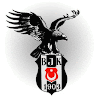As soon as he joined the group in 1989, Xavier de la Chapelle decided to change the name “MVS” to “Venturi” which, up until then, had been the name of the leading model produced by the Nantes-based brand. After rejecting over 80 draft proposals, Xavier de la Chapelle opted for a logo illustrating the gerfalcon (the world’s fastest animal, capable of attaining a speed of 280 km/hr in a vertical dive) set on a glove, which symbolises mastery. All topped by the sun of the region of the Loire in red, white and blue. Venturi kept the oval shape of its former logo, to retain the dynamic image of the French GT brand. MVS became Venturi and moved from Cholet to Couëron, near Nantes. Two towns in the noble region of the “Pays de Loire”. In hommage to this region, the shape of the "V" recalls a shield bearing its coat-of-arms.
1989 : from the MVS logo to the Gerfalcon logo
Colors
The logo is composed of three colors : red, white and blue, a reminder of the brand’s French origins. Red is the dominant color, recalling the previous “MVS” logo.
The sun
This is an esoteric symbol representing the region of the Loire, the brand’s original home. One will notice a difference in tone, rather like “Yin and Yang”, a reminder that Venturi always searches for the best compromise. Its mysterious aspect thus draws attention, like “Venturi”.
The Gerfalcon
The gerfalcon lives in certain regions of the Arctic, but also in Asia and Iceland. It is the largest and fastest of all the falcons. Like Venturi, it is rare, sought-after, tamable, fast and powerful ! It is highly-prized for its majesty and represents the very best in terms of falconry. The bird of prey raises its wings, it is dynamic and forms a “V”. One can eaasily distinguish its feathers, symbols of lightness and perfection.
The glove
The gerfalcon stands on a glove. It is controlled by its master, as a Venturi is controlled by its driver, who often also wears gloves. Venturi is thus “controlled power”.
2001 : from the Gerfalcon to the "V"
The company’s takeover in 2001 was accompanied by the appearance of the new Venturi logo, a red “V” against a black or white background. It symbolises the brand’s new dynamism and the sobriety of its new models. Red has been kept to express the passion that emanates from the various models built over a period of more than 20 years. The “V” is either used with a white background, a reference to the brand’s new home (Monaco), or with a black background. The Gerfalcon is still, however, used in competition so as not to forget the brand’s glorious past in car racing. The Fétish also proudly bears this rare bird on its hood and marks the transition with the new logo which will be found on new models.
History of the brand
1984 : The very first Venturi, the brainchild of Claude Poiraud and Gérard Godfroy’s combined genius, was unveiled at the Paris Motor Show. The goal was to present the only “Grand Tourisme” French car, while retaining it’s light weight of 850kg for a cylinder capacity of two litres. The headquarters of the company were located in the Pays de Loire in Coueron (44) where almost 700 cars were produced in 20 years.
Renowned for the excellent roadholding of their cars, Venturi has employed innovative methods in many other ways. The 400 GT remains the best performing French car ever produced, it is in fact the very first car in the world to have standard carbon brakes.
High level competition has also brought fame to the brand. Venturi was at the origin of the memorable “Venturi Gentlemen Drivers Trophy”, which gathered an impressive array of 75 drivers.
Venturi has also won fame through its brilliant performances in the Le Mans 24 hours race, particularly in 1993 with Christophe Dechavanne and Jacques Laffite on Venturi Jaccadi team, and in 1995 with Paul Belmondo racing on the 600 SLM.
With the creation of the Venturi-Larrousse team in 1991, Venturi even gave Formula 1 a try.
However it is in the international GT races that Venturi established its pedigree defeating Porsche and Ferrari on several occasions. 1994 was the crowning year for Venturi: in Dijon, with Ferté and Neugarten on the 600 LM Jaccadi, at the 1000 km of Paris with Pescarolo and Basso on the 600 LM, and finally at the 4 hours Spa race, once again with Ferté and Neugarten.
In 2001: Gildo Pallanca Pastor takes Venturi’s destiny in his hands.
Reference:http://www.venturi.fr/venturi-corporate-history-of-the-logo.html















0 yorum:
Post a Comment